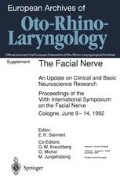Abstract
The normal function of the forehead muscle after severe damage to the facial nerve, and especially after nerve reconstruction in the trunk region, cannot be regained. This striking phenomenon was described as early as in 1936 by Martin and in 1948 by Tickle [1,5]. Miehlke (1973), in his classical monograph [2] on the “Surgery of the Facial Nerve” summarized this fact as follows: “Every expert in the surgery of the facial nerve knows about the repeatedly mentioned experience that, after a lesion of the facial nerve, recovery of the frontal part of the occipito-frontal muscle is either incomplete or non-existent. This is almost the rule after neurotmesis… The peculiar behavior of this muscle is not yet explained”, and he continued: “One might be permitted to think that the frontal part of the occipito-frontal muscle has some special tendency toward atrophy and fibrosis” (p. 239).
Access this chapter
Tax calculation will be finalised at checkout
Purchases are for personal use only
Preview
Unable to display preview. Download preview PDF.
References
Martin RC., (1936) Surgical repair of the facial nerve. Arch Otolaryngol 23: 458
Miehlke A., (1973) Surgery of the Facial Nerve. Urban and Schwarzenberg, Munich
Sobotta-Becher J., (1957) Atlas der deskriptiven Anatomie des Menschen, Teil 1, Urban and Schwarzenberg, Munich
Stennert E., (1982) Das Autoparalytische Syndrom — ein Leitsymptom der postparetischen Fazialisfunktion. Arch Otorhinolaryngol 236: 97–114
Tickle TG., (1948) Surgery of the seventh nerve. JAMA 136: 969–972
Author information
Authors and Affiliations
Editor information
Editors and Affiliations
Rights and permissions
Copyright information
© 1994 Springer-Verlag
About this paper
Cite this paper
Stennert, E. (1994). Why Does the Frontalis Muscle “Never Come Back”? Functional Organization of the Mimic Musculature. In: Stennert, E.R., Kreutzberg, G.W., Michel, O., Jungehülsing, M. (eds) The Facial Nerve. Springer, Berlin, Heidelberg. https://doi.org/10.1007/978-3-642-85090-5_25
Download citation
DOI: https://doi.org/10.1007/978-3-642-85090-5_25
Publisher Name: Springer, Berlin, Heidelberg
Print ISBN: 978-3-540-57686-0
Online ISBN: 978-3-642-85090-5
eBook Packages: Springer Book Archive

